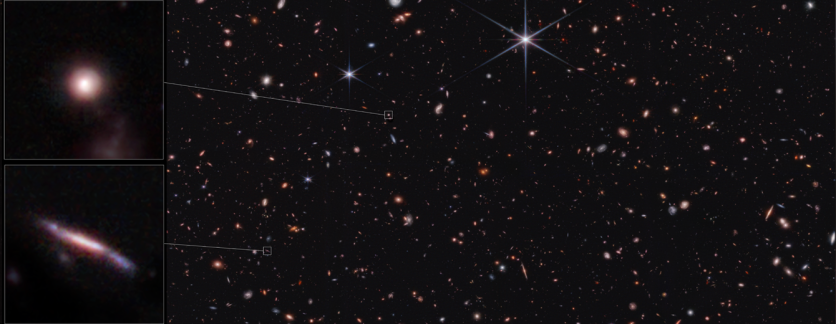Researchers using NASA's James Webb Space Telescope have found that many early distant galaxies bear a striking resemblance to everyday objects like pool noodles.
Rather than the familiar spirals or elliptical structures found in nearby galaxies, they have spotted distant galaxies shaped like volleyballs, frisbees, pool noodles, and surfboards.

NASA's James Webb Space Telescope Dives Into a Cosmic Ocean
The telescope's data analysis revealed a surprising prevalence of surfboard- and pool-noodle-shaped galaxies during a specific epoch, ranging from 600 million to six billion years ago.
According to NASA, this discovery challenges the established norms observed in galaxies closer to us, which often exhibit clear spiral patterns or smooth elliptical forms similar to frisbees or volleyballs.
The study, based on the Cosmic Evolution Early Release Science (CEERS) Survey's near-infrared images from Webb, uncovered that 50 to 80% of the galaxies studied displayed a flattened, elongated structure.
Lead author Viraj Pandya, a NASA Hubble Fellow at Columbia University, emphasized the uniqueness of these shapes in the early universe, considering their infrequency in closer galactic proximity.
Galaxies reminiscent of surfboards and pool noodles stood out in the CEERS Survey, capturing the imagination of scientists. On the other hand, other shapes, such as frisbees and volleyballs, added further diversity to the cosmic panorama.
"Volleyball" galaxies, or those with spherical shapes, were less common but more compact, resembling a rare type on the cosmic "ocean."
Read Also : NASA's James Webb Space Telescope Discovers Signs of Possible Aurorae in Extremely Cold Brown Dwarf
Did the Milky Way Look Like a Surfboard in the Past?
While contemplating the hypothetical past of our Milky Way galaxy, the researchers speculate that it might have appeared more like a surfboard when rewinding the cosmic clock by billions of years.
"Our best guess is that it might have appeared more like a surfboard," said co-author Haowen Zhang, a PhD candidate at the University of Arizona in Tucson.
This hypothesis is based partly on new evidence from Webb - theorists have "wound back the clock" to estimate the Milky Way's mass billions of years ago, correlating with shape at that time.
Notably, these early galaxies identified by Webb are less massive than their counterparts in the nearby universe. They serve as precursors to more massive galaxies, including our Milky Way.
Webb's capabilities, including high sensitivity, resolution, and specialization in infrared light, facilitated the quick characterization of numerous galaxies from the CEERS Survey.
The researchers acknowledged the foundational contributions of NASA's Hubble Space Telescope, which laid the groundwork for understanding distant galaxies.
Webb's imaging prowess has complemented Hubble's legacy, revealing many distant galaxies beyond Hubble's reach and offering unprecedented details about the early universe. These findings, akin to a cosmic swell, affirm and enhance the observations of elongated galaxies made by Hubble over the years.
While the early results are promising, researchers acknowledge the need for a more extensive sample size from Webb to refine our understanding of distant galaxies' properties and locations. Ongoing efforts involve fine-tuning models to accurately represent the intricate geometries of these enigmatic celestial structures.
Related Article : NASA's James Webb Space Telescope Finds Something Weird Inside Mysterious 'Brick' in Milky Way

![Apple Watch Series 10 [GPS 42mm]](https://d.techtimes.com/en/full/453899/apple-watch-series-10-gps-42mm.jpg?w=184&h=103&f=9fb3c2ea2db928c663d1d2eadbcb3e52)



